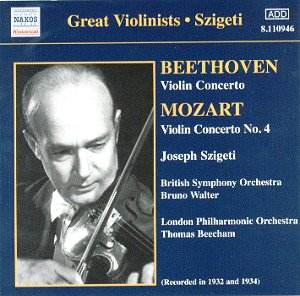Two of Szigeti’s greatest concerto recordings were
recorded in London between 1932 and 1934, when he was at something like
his prime, and are conveniently harnessed in this super-budget Naxos
‘Great Violinist’ release. The Mozart is one of three recordings made
with the LPO and Beecham – the others were the Mendelssohn and Prokofiev
1 – and the conductor’s contribution to this Mozart performance is characterized
by note writer Tully Potter as "brusque … and slapdash." Presumably
therefore Szigeti’s marvellous performance worked in spite of, not because
of, the conductor – not an argument I would be prepared to follow too
far. In fact Beecham’s accompaniment is perfectly acceptable and animates
Szigeti’s sometimes miraculous playing to a large degree. The violinist
is stylish and aristocratic in equal measure, utilising the Joachim
cadenzas, reaching a peak in the slow movement, a benchmark performance
by which I judge all other recordings. He vests the lyric phrases with
a chaste intensity seldom experienced in Mozartian concerto performances.
The contrastive material is charmingly intensified by Szigeti, rather
than being allowed to dissipate, Beecham encouraging orchestral pizzicati
that are properly energetic and characterful. Throughout the conductor
offers warm and generous support. Szigeti’s elastic phraseology comes
to the fore in the Rondo finale, panache and elegance co-existing in
perfect accord. Of the musicians of Szigeti’s generation probably only
Thibaud was as elegant and convincing a Mozartian and when the Frenchman
was finally taped in the D major, off-air in 1951 with Enescu conducting,
his technique had long since withered leaving behind just the wonderful
instinct for phrasing.
Szigeti recorded the Beethoven Concerto three times,
twice with Bruno Walter conducting. The 1932 Walter recording was followed
by a New York Philharmonic one in 1946, the trio being completed by
the Dorati accompanied LSO recording of 1961, by which time the violinist
had been in long and steady decline (horror stories of the violinist’s
frailties have emanated from the LSO Dorati/Menges sessions of 1959/61).
The 1932 performance is a thoroughly impressive one though not without
its idiosyncrasies. One of the most obvious is Walter’s highly subjective
handling of the orchestral introduction, his frequent intemperate accelerandos
invariably accompanied by an increase in orchestral volume, none of
which ideally prepares for the violinist’s broken octaves entry. There
is also some booming bass in the acoustic of Central Hall, Westminster,
which can occasionally serve to cloud and occlude the lower string line.
But it is to Szigeti that we must turn to appreciate the true stature
of the reading – his portamenti are expressive, his line fuses animation
with relaxation, whilst conveying all the while a sense of involving
depth. In the Larghetto, moments of pregnant expressive meaning are
infused with subtly increased vibrato usage and colour, his portamenti
beautifully apt and clear, those "backward" portamenti for
which he was (in)famous always constructively employed. His correlation
of individual episodes here is of the highest architectural acuity and
his playing of singular beauty, even if tonally he lacks precisely that
quality; at moments such as this it’s of little account. His Rondo finale
is full of fresh air, with some deliciously quick and easeful slides
accompanying him, and a sense of conclusive surety and delight in the
playing.
The transfers have been well handled by Mark Obert-Thorn.
As for the performances – well these are indispensable cornerstones
of a collection, and not just a historical collection.
Jonathan Woolf
